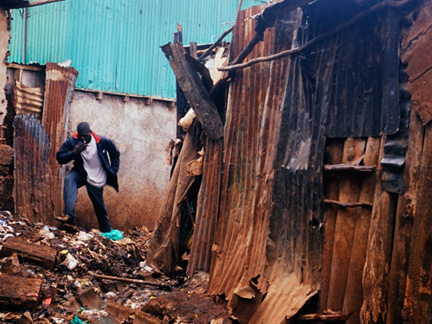Interview - Magnum
Modernising Magnum: In Motion for the web
by Aidan O'Donnell
Article published on the 2009-08-18 Latest update 2009-08-26 11:07 TU
The In Motion section brings together combinations of photos, audio, video, graphics, and interactivity.
"It was our reaction to what was going on in news media," says In Motion Managing Director Mark Lubell, referring to fewer assignments and even fewer opportunities for photojournalists to showcase their work.
So what's the recipe for a webdocumentary? Is there anything resembling an accepted format or is one format dominating? How many parts audio to how many parts interactivity to cook up a successful webdocumentary?
The answer, unsurprisingly, is that it depends on the photographer.
"You might have, for example, Martin Parr, take you through a large body of his work so you can understand Martin Parr's approach to photography," says Lubell.
"Chris Anderson was in Lebanon during the attacks in Lebanon and he was shooting both still and video and sound recording and putting it together at night and then we would put it up the next day," says Lubell.
Lubell says that Magnum had to design its own flashplayer to give them sufficient control of the various elements. This, so that the user "could move around the story in different ways" and not just in a linear mode.
There is a separate format which presents video, images and sound, and this one is "linear in the way we present it," he says.
Running a department like In Motion within Magnum necessitates an in-house team of three full-time people, a few interns and some part-time workers. They also have about four freelance producers who will come in from time to time to work on certain projects.
The number of staff needed to run this "always comes back to the photographer - how much or how little they need help with."
Lubell says that traditionally, photographers have been very skilled at producing well-thought-out photography books or exhibitions.
"They understand the medium, they understand the rhythm and the pacing and what they want people to see, and not see, until certain moments," he says.
But the challenge now will be "how to tell really dynamic stories using the internet," he says. "There's a lot of stuff out there that you could say this is a webdocumentary, or that is a webdocumentary, or this is webjournalism - but it's still moving, it's still being developed."
Lubell says that people usually click off internet video after less than a minute, but the In Motion site is managing to hold web surfers for up to eight minutes.
The figures for the site itself are around 400,000 but their reports are sold and licenced to sites like slate.com, slate.fr, stern.de or lemonde.fr which can quickly run into the millions of views per month.
Aiming for audiences with high-speed fibre connections can be a lucrative exercise. But can that trump a black & white photo that was wired to newspapers around the world, especially in countries without high-powered internet infrastructure?
"The day-to-day consistency that a newspaper or a magazine has with its own consumer audience usually, on average, outweighs one website," he concedes, "but you have to be looking at three, four, five years from now."
The ultimate unanswered question however is how to get the general public to pay for this kind of content.
"People are happy to pay 99 cents for a song, but 'how dare you charge anyone five cents for an editorial?' And that is the big question that all of the major newspapers and magazines are having now."






